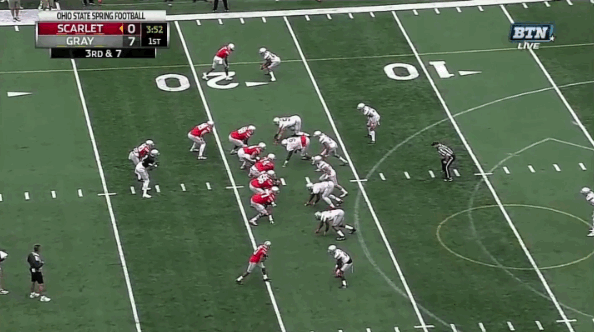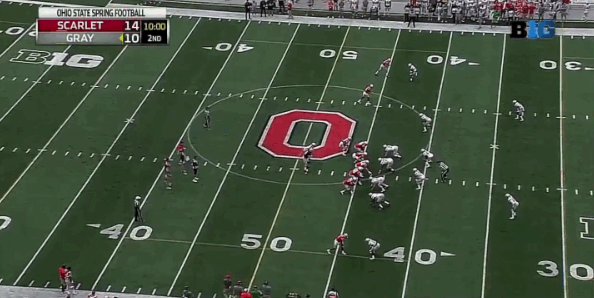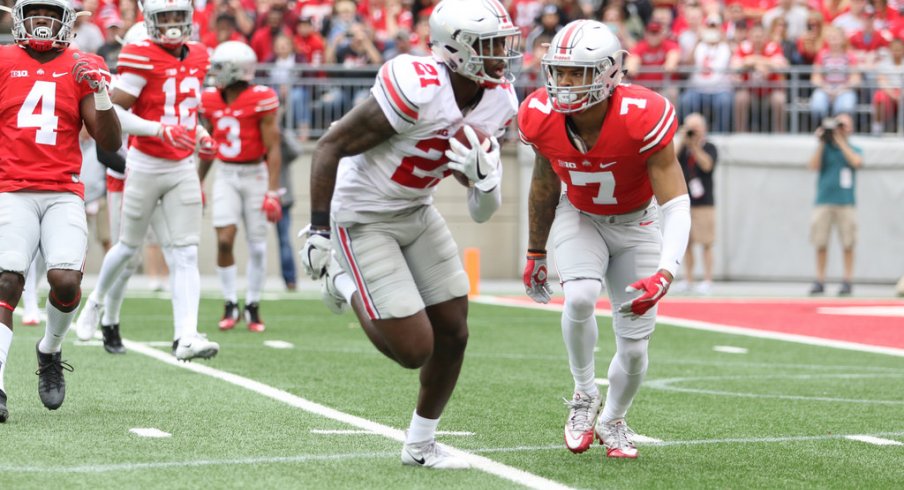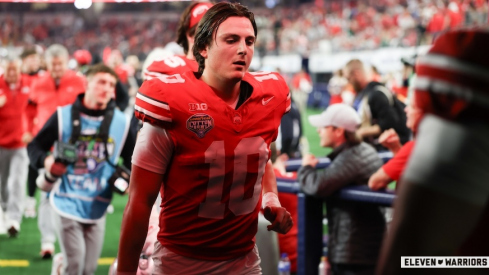Expectations were high, to say the least.
With the additions of a spread-offense 'guru' in new coordinator Kevin Wilson and a quarterback coach with NFL experience in Ryan Day, everyone in and around the Ohio State football program hoped to see signs of growth in the passing game during the team's 15 spring practices that wrapped up last Saturday in Ohio Stadium. Unlike past spring games that heavily favored the running game in and effort to instill the fundamental aspects of Urban Meyer's power-spread offense, this year's scrimmage was almost exclusively focused on throwing the ball, and for good reason.
With four returning starters on the offensive line and 1,000-yard rusher Mike Weber back this season, there is little need to show what that group can do on the ground. But even with quarterback J.T. Barrett entering his fourth year as a starter, the nation's 81st-ranked passing offense in 2016 must find new faces to replace the departed Curtis Samuel and Noah Brown while building chemistry for the fall.
The result was over 600 combined passing yards and seven touchdown passes in a high-scoring affair that saw a number of new targets emerge for Barrett and fellow signal-callers Joe Burrow and Dwayne Haskins. Those expecting to see an entirely new identity on offense may have been disappointed, as the Buckeyes still used many of the same personnel groups and formations as we've seen from the past. But there were some new wrinkles that can be thanked for many of those big pickups through the air.
Across The Middle
Last season the OSU passing game operated largely outside the hash marks, looking to create space for Samuel with concepts like H-option, as well as three-man route combinations like Snag. The latter was still heavily featured Saturday, but many of the underneath concepts we saw in the game have largely been absent from previous Buckeye game plans.
One concept that was called early and often was 'Shallow Cross,' a play often associated with air-raid offenses, but whose roots can be traced back to Bill Walsh.
This simple high-low read puts a zone defender in the middle of the field in a position to always be wrong, without taking much time to develop. As SmartFootball.com's Chris B. Brown once wrote:
The shallow cross is, quite possibly, the best pass play in football: Almost any quarterback can complete it; almost any receiver can run it (though there is more nuance than maybe one might initially realize to a good shallow route); it is a way to get “speed in space” without requiring a big arm; it works against most all coverages; and throwing a few of these tends to open up big plays downfield as defenders creep up.
Not only is this an easy decision for the quarterback, it's also a fairly easy throw, something we rarely saw last fall. Even on quick throws that got the ball outside, Barrett was actually throwing the ball as far as 30 yards through the air on a play that would only gain five or six, adding an unnecessary level of difficulty.
When the Buckeyes did try to hit other crossing concepts like Mesh in 2016, the entire unit seemed out of sync. To remedy the situation and free up dynamic runners like Parris Campbell and K.J. Hill, the most likely candidates to replace Samuel as Columbus' resident playmaker, Wilson pulled out a wrinkle for the concept made famous by Mike Martz while running the St Louis Rams' Greatest Show on Turf offense.
Though the defense was in man here, this concept is similar to Shallow Cross in that it should work against virtually any coverage. Here, the offense crosses three receivers instead of just two, all at different levels, with the player running the most shallow route coming free as his defender gets caught in traffic. Throws like these make any QB's job much easier as a completion will almost certainly lead to extra yards after the catch.
Going Deep
The Buckeyes' recent struggles with the deep ball are well-documented, as was its focus throughout spring practice. Everyone involved with the passing game knew the importance of connecting downfield in the coming season.
While scheme and talent can certainly help change that equation, a focus on technique is the biggest difference from 2016, as we saw from the Scarlet team's first touchdown. Schematically, the call was nothing special: a classic "shot" play in which the offense ran only three receivers straight downfield, simply looking to win an individual matchup.

The corner, Rodjay Burns, plays the ball well, hardly allowing Johnnie Dixon to gain separation. However, Haskins hits his drop in rhythm, planting off his back foot and driving through his motion to deliver a tight spiral to the designated landmark. Meanwhile, Dixon does a great job of finding the ball early in its flight, as well as fighting off the defender just enough to go up and get the ball.
Credit where credit is due. This effort was a far cry from the discombobulated effort we saw regularly in 2016. Day and receivers coach Zach Smith clearly prioritized execution by repping routes like these constantly over the past month.
However, it wasn't just an effort thing, either. The group has worked hard to establish landmarks based on route and field position for these downfield throws, allowing both quarterback and receiver to know where the ball is supposed to go, which Barrett noted after the spring game.
“I think before we weren't necessarily making them at first but with Coach Wilson and Coach [Ryan] Day, each finding landmarks for those throws, keeping them from the boundaries,” said the senior quarterback. “So the receivers understand where it's going to hit at and then also those guys run hard and beating those guys downfield. Because our defense plays man across the board. As it got towards the end I think we did a really good job of completing the deep ball.”
Of course, it certainly helped that an explosive player like Dixon finally emerged as a player with not only the speed to gain a step on his opponents, but also the body control to fight through contact and haul in a deep pass. On his second touchdown of the day, we'd see both traits in action, as a stutter-and-go concept, similar to the one we saw from Michael Thomas in Blacksburg two years ago, gave Dixon a step on heralded transfer Kendall Sheffield before the wideout wrestled his way into the end zone.

But Wilson and the offense also showed some schematic wrinkles to get receivers open downfield. The very first pass of the game was the familiar Sail/Flood concept that is clearly one of Meyer's favorites. Walk-on wideout Ke'von Huguely's surprise 35-yard touchdown catch in the second quarter came from the Fade/Smash concept referred to as 'Bama' which periodically showed up in OSU game plans last fall.
However, the best example of a new concept in the downfield passing game was the wheel concept that freed up Demario McCall on a wide-open 40-yard touchdown catch.
The fake quarterback-counter helped this play succeed in two key ways:
- The run-fake held the attention of the linebackers just enough to delay their pass drops, taking their eyes off the receivers and allowing the "pick" to be set up properly
- Burrow was in much better rhythm by the time McCall had sprung free downfield and wasn't just standing back in the pocket waiting
The play design was an excellent example of creatively incorporating different players (i.e. a running back) to stress the defense downfield in new ways, something we'll hopefully see more of in the fall.
Empty on the Goal Line
The final, and perhaps most overlooked, wrinkle we saw in the spring game came deep in the red zone. Though the offense kept its base '11' personnel on the field with one running back and one tight end, the unit lined up in a five-wide formation, leaving the quarterback alone in the backfield.
With a running threat like Barrett standing back there, the defense can't spread out too much, as he's talented enough to slither through a gap and find the end zone. However, they must respect the threat of the pass as well, and are forced to show their hand before the snap as a result.
The simple act of walking the linebacker out all the way to the sideline to cover the running back is a clear marker that the defense is in man. From there, the play-call is a simple read that adapts to either man or zone. Tight end A.J. Alexander does a nice job gaining outside position on the safety in coverage, but both he and Barrett knew he'd be able to do so before the ball is snapped.
There isn't anything especially inventive about any of these wrinkles, as the concepts themselves certainly aren't new. However, they show that even the slightest modifications can, and hopefully will, make major improvements to the Ohio State passing game's efficiency and effectiveness come the fall.



